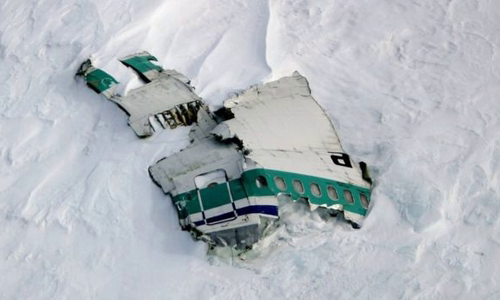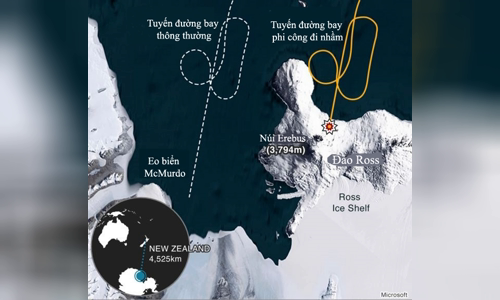When a scenic plane carrying 257 people crashed into a volcanic cliff in Antarctica in 1979, it became the worst disaster in New Zealand in peacetime.
Since 1977, Air New Zealand has begun operating sightseeing flights in Antarctica and achieved great success. This journey becomes the ideal day tour, when visitors take only a total of 11 hours to fly across the country, to the vast Antarctic continent and then return to Auckland. The airline offers the most luxurious service with stunning views below.

A fragment of a DC-10 aircraft in a 1979 tragedy on Mount Erebus in Antarctica Photo: Phil Reid/Antarctica New Zealand.
Since 1977, Air New Zealand has begun operating sightseeing flights in Antarctica and achieved great success. This journey becomes the ideal day tour, when visitors take only a total of 11 hours to fly across the country, to the vast Antarctic continent and then return to Auckland. The airline offers the most luxurious service with stunning views below.
Nearly 13:00 on November 28, 1979, the ground collision warning system issued an alarm signal when the McDonnell Douglas DC-10 aircraft faced the Erebus volcano on Ross Island, but the pilot could not raise the altitude. . Only 6 seconds later, the plane crashed into the cliff.
After several hours of waiting and no communication, New Zealand authorities hypothesized that the plane was running out of fuel. Search and rescue operations quickly began and they realized that all 227 passengers and 30 crew members were killed, including 44 people were not found.
According to the initial investigation, the disaster stemmed from the pilots' flight that was different from the regular route. They thought they were traveling across the McMurdo Strait like previous flights, but in reality the aircraft was on Ross Island, where the Erebus volcano is 3,794 m high.
The second reason is due to a weather phenomenon called "white-out", when the light between the snow and snow below creates the illusion of vision, causing the pilot to think that white which he saw through the cockpit window was simply ice and snow, not ridge.
"The same accident will not occur with a modern aircraft. The current equipment is extremely good. Thanks to the satellite-based navigation system, it is impossible to go the wrong way," the captain said. Andrew Ridling, head of the New Zealand Aviation Pilots Association, said.
The population of New Zealand at that time was only about three million. Almost all have links to the accident, whether acquainted with victims or members of the rescue force, or join the sides in the legal battle that followed. The tragedy surprised the whole country.
"It happened at a time when the relatively young nation was going through an important stage in the search for a new identity," explains historian Rowan Light at the University of Canterbury. "In the 1960s and 1970s, the old image of New Zealand as a progressive British Empire no longer mattered."
New Zealand was trying to adapt to the new situation and find its own place. Technological advances have played an important role in this process, and infrastructure is the key to building the story of settling, conquering and gaining control of the country. Reaching Antarctica, some 4,500 km to the south, fits this scenario perfectly.
However, a series of tragedies has shaken the faith of New Zealanders violently. Before the Erebus mountain disaster, a train accident in Tangiwai in 1953 killed 151 people and the sinking of the Wahine ferry in 1968 also killed the lives of 51 people. "These incidents make them really suspicious of control and technological progress," says historian Light.
The legal battle that broke out after the plane crash continued to strike a second blow to New Zealanders. They are shocked by the failure to determine exactly what happened, as well as accusations of mutual blame.

Flight route of DC-10 aircraft (yellow) Photo: BBC
The initial investigation basically assumed that the fault was with the crew. The pilot has traveled below the minimum safe height specified by the airline. Despite the finding of a deviation in the flight path, the conclusion was that the plane would escape if flying higher.
Flight route of DC-10 aircraft (yellow). Graphics: BBC.
Since 1977, Air New Zealand has begun operating sightseeing flights in Antarctica and achieved great success. This journey becomes the ideal day tour, when visitors take only a total of 11 hours to fly across the country, to the vast Antarctic continent and then return to Auckland. The airline offers the most luxurious service with stunning views below.
The DC-10 was indeed flying below safe altitude, but the investigation found that Air New Zealand's Antarctic flights frequently dropped to such extremely low levels to serve the needs of sightseeing and shooting. customer photo. Even flyers use clear pictures taken from below safe levels.
The Royal Investigation Commission not only found Air New Zealand's fault in the flight's mistakes, but also accused the airline of trying to hide this with a conspiracy to blame the flight crew, "waving its hands" to all the blame. responsibilities, including compensation for the victims' families.
Since 1977, Air New Zealand has begun operating sightseeing flights in Antarctica and achieved great success. This journey becomes the ideal day tour, when visitors take only a total of 11 hours to fly across the country, to the vast Antarctic continent and then return to Auckland. The airline offers the most luxurious service with stunning views below.
The accident with the TE901 flight is also a blow to the reputation of Air New Zealand, the national airline used to be the pride of the country. After many years, most people thought that Air New Zealand was really the fault, not the pilots. The airline finally apologized in 2009, but only because of their behavior after the accident, not because of the responsibility for causing the tragedy.
40 years have passed, but the accident still holds an important position in the history of New Zealand. For generations after the war, this was the biggest domestic tragedy they had ever witnessed. From that moment on, the young nation seemed to lose its "innocence", as well as its belief in normal social orders.
Even so, there is no national monument yet for the victims. A crucifix and a stone fern-shaped stone figure, the symbol of the Maori natives, were placed near the site of the accident. Families of the victims held a number of memorial services on Ross Island, but the form of the memorial also caused controversy.
New Zealand's government earlier this year approved plans to build a memorial in Auckland, a project that Prime Minister Jacinda Ardern said would "reflect the tragedy of the accident, and strongly reminded". about connection and loss ".
The remnants of the DC-10 plane remain on the side of Mount Erebus under the snow, silently preserving memories of the fateful flight.



 WalterPurdion
WalterPurdion








